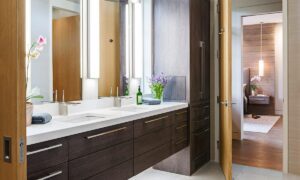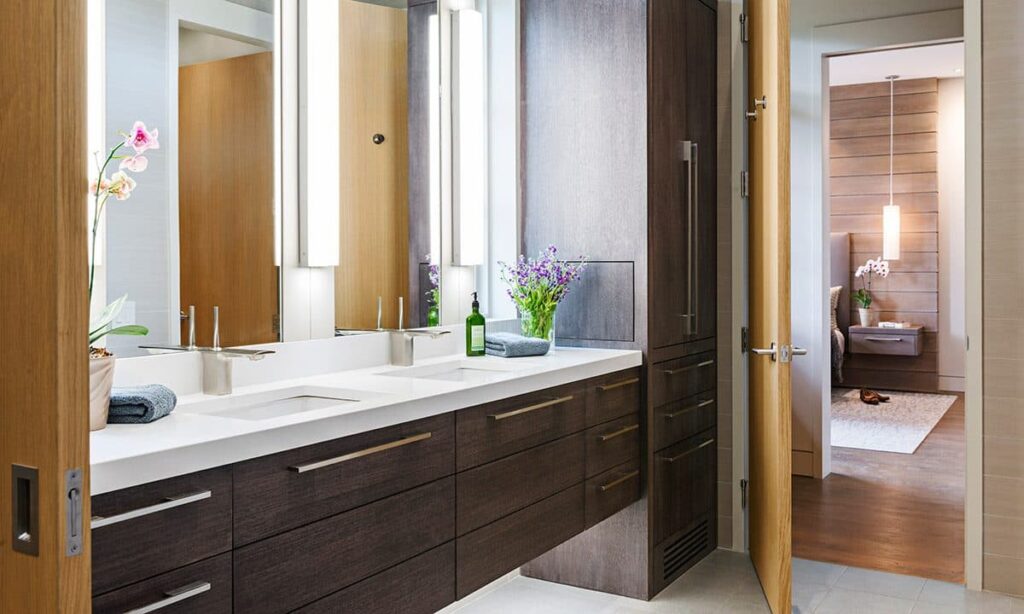When it comes to choosing casework and millwork for a project, often the choice comes down solely to cost.
This can lead to casework with a limited lifespan, made of poor quality materials that off-gas formaldehyde and other chemicals.
Thankfully, there are many options for sustainably produced products and materials. To identify these products, often all that is required is to ask some simple questions of your casework or millwork supplier: What percentage of recycled content panel product do you use? What about water-based catalyzed lacquer? And how about your internal recycling program?
Let’s consider a standard set of kitchen cabinets, exploring the design and materials to see where opportunities exist to make sustainable choices.
Construction style

With Nathan Bryant of Samsel Architects as architect and Traci Kearns of Alchemy Design as interior designer, this home was crafted to incorporate sustainable cabinetry.
There are two basic cabinet construction methods: traditional face frame and frameless or European.
In frameless cabinets, the wood face frame is eliminated and the edge of the cabinet box is banded with one of several different types of thin (0.5mm to 3mm) edgebanding material—either PVC (polyvinyl chloride), ABS (acrylonitrile butadiene styrene), solid wood or wood veneer. Any style of door and drawer front can be used, and most frameless cabinets look nothing like the sleek modern designs the name might imply.
This construction method maximizes the space within the actual cabinet box, making more with less, and eliminates several board feet of lumber required to make the face frame. Choosing frameless cabinet construction is a good start.
For the edgebanding itself, ABS is preferred over PVC in green-building terms, however it is used less frequently and available in fewer colors than PVC. Ask your supplier to source ABS edgebanding if the option exists, as the major manufacturers of edgebanding are bringing more products to the market.
The wood or wood veneer option is the best choice, offering the ability to exactly match wood doors and drawer fronts or be painted to match the cabinet fronts if required.
Panel Products
Hardwood plywood panels are a superior choice for all casework projects. Typically using a birch or poplar core, hardwood plywood is available with many different wood species as the face (exposed) veneer surface. Prefinished panels are available with a UV (ultraviolet light-cured) coating that provides excellent durability and easy cleaning of the cabinet interiors while eliminating the hassle and potential off-gassing associated with other on-site or shop-based finishing methods. Hardwood plywood certified by the Forest Stewardship Council (FSC) can also be sourced, though wood species choices may be limited and cost can be 20 to 30 percent higher than non-FSC panels.
One hardwood plywood product worthy of direct mention is Columbia Forest Products PureBond, which uses a unique soy-based glue in the manufacturing process to eliminate off-gassing and provides great sustainability benefits due to its natural-based composition. Columbia has a local manufacturing plant in Old Fort, allowing for material sourced within a 100-mile radius. (Their UV-finished products come from Chatham, Virginia, though that is still within the generally accepted 500-mile radius for material sourcing.)
Hardwood plywood offers higher strength and greater longevity than other products, providing an improved life-cycle cost assessment. Medium-density fiberboard, known simply as MDF, is a panel product composed of glue and wood fiber. MDF’s low cost, stability (less likely to warp or twist), and smooth finishing ability make it a popular choice for painted casework and millwork as well as a substrate for laminates and veneer work. MDF can be sourced with non-UF (urea formaldehyde) glues and is also available with FSC-certification. Again costs are higher—approximately 15-25 percent more than standard MDF, depending on the panel manufacturer.
Alternatives are also available. Bamboo plywood is one that offers the ability to have a structural panel and exposed face with a unique look all in one. It is frequently used for cabinet fronts and furniture. Though less readily available, there are also panels produced from wheat stalks and other agricultural byproducts.
Finishes
Gone are the days when you had to air out a project for days after the casework was installed. The long tradition of nitrocellulose lacquers and other hazardous and noxious finishes is evaporating like a can of lacquer thinner.
Water-based and other low-VOC (volatile organic compounds) finishes are making their way into every manufacturer’s product catalog. These finishes offer equal durability to the traditional nitrocellulose products and are available in various sheens in both clear and tinted (solid color) versions, so matching that vintage avocado green range is easily accomplished.
Soy-based finishes are another option that a few specialty finish manufacturers offer. Durability may be an issue in high-use wet areas like bathroom vanities.
One product in this category that bears direct mention is Rubio Monocoat. Rubio is a hybrid wax and linseed oil all-natural based product that offers zero VOCs and a simple one-coat finishing process. It is typically used as a floor finish, though it works perfectly well for cabinets, furniture and other casework.
Veneer
Veneer-based construction has been around for hundreds of years, yet many people only associate it with cheap furniture from the 1950s.
What most people don’t know is that the highly figured woodwork and casework they admire is veneer work. That gorgeous ribbon Sapele-lined elevator cab at the fancy hotel? Veneer. The antique dining table with the Walnut crotch-figured top and matching leaves from your grandmother? Veneer.
Veneer is thin (1/42” is typical), solid wood that has been sliced from whole logs. The amount of material generated from each log is maximized, making it an excellent sustainable choice.
Typically, the best and highest quality logs are culled out and sent to the veneer mills, providing some of the most exciting and sought-after figures and cuts—many that are unavailable in solid lumber. Specialty cuts, like quarter-sawn White Oak, are readily available in veneer for a more reasonable cost than in solid lumber.
Veneered panels can be used for cabinet doors and drawer fronts, millwork (including curved work), interior and exterior doors, furniture and any other built-in or freestanding casework that you can think of.
Veneer provides the beauty and organic benefits of solid wood with a reduced environmental impact.
Hardware
Think closely about the places where you actually interact with the casework.
Choosing high quality hardware—drawer slides, hinges, accessories and pulls or knobs—is always a better choice in the life-cycle assessment of a sustainable project, and higher quality typically means greater functionality.
Cabinet hardware that allows greater access to the interiors, especially blind corners and deep cabinets or closets, can maximize storage space, thereby making more room from less space—a true tenet of sustainable design.
In-house operations
Other simple questions to ask your supplier include:
- Do you recycle? What do you do with wood waste, scrap metal, shipping materials?
- How about your suppliers? Consider distance to them, shipping of materials and their sustainability measures.
- What about the distance to the project? Remember: “Love Local.” If you as the contractor shop at Earth Fare, why would get your cabinets from Ikea?
Hopefully this brief look has given you some ideas and insight about what to consider when sourcing the casework and millwork for your next project. It can be as simple as asking, “Is there soy in your cabinet?”
Joe Archibald is an architect and contractor living in Asheville with more than 20 years experience in the residential construction industry. He operates Narwhal Design | Build, a craft-based design and construction firm with the intent to create a built environment that respects the natural condition, engages the people who use it and rewards those who participate in its construction.
You can also view this article as it was originally published on page 60 of the 2017-18 edition of the directory.


